 |
| |
Switch to: Europe, USA, New Zealand, Antarctica
Credit: NOAA/Ovation
 Planetary K-index
Planetary K-index
Now: Kp=
5.00 storm
24-hr max: Kp= 8.00 severe
explanation | more
data
Interplanetary Mag. Field
Btotal: 14.58 nT
Bz: -6.61 nT south
more data: ACE, DSCOVR
Updated: Today at 0636 UT
 Coronal Holes: 01 Jun 25
Coronal Holes: 01 Jun 25
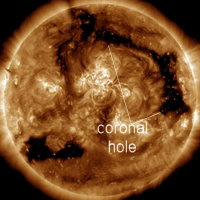
Earth is inside a solar wind stream flowing from this long, narrow coronal hole. Credit: NASA/SDO | more data

Polar Stratospheric Clouds
Colorful Type II polar stratospheric clouds (PSC) form when the temperature in the stratosphere drops to a staggeringly low -85C. NASA's MERRA-2 climate model predicts when the air up there is cold enough:
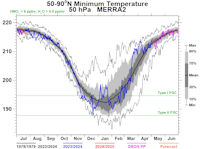
On May 27, 2025, the Arctic stratosphere is much too hot for polar stratospheric clouds. | more data.
Noctilucent Clouds
The southern season for noctilucent clouds (NLCs) is finished. The first clouds were detected over Antarctica on Nov. 19, 2024, and they vanished again on Feb. 21, 2025. The action will shift to the north pole in late May 2025. Until then, the map will remain blank.
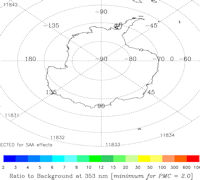
Updated: Feb. 21, 2025
An instrument onboard NOAA 21 (OMPS LP) is able to detect NLCs (also known as "polar mesospheric clouds" or PMCs). In the daily map, above, each dot is a detected cloud. As the season progresses, these dots will multiply in number and shift in hue from blue to red as the brightness of the clouds intensifies.

SPACE WEATHER
NOAA Forecasts |
|
Updated at: 2025 May 31 2200 UTC
FLARE |
0-24
hr |
24-48
hr |
CLASS M |
65
% |
65
% |
CLASS X |
25
% |
25
% |
 Geomagnetic Storms:
Geomagnetic Storms:
Probabilities for significant
disturbances in Earth's magnetic field are given for three activity levels: active, minor
storm, severe
storm
Updated at: 2025 May 31 2200 UTC
Mid-latitudes
|
0-24
hr |
24-48
hr |
ACTIVE |
05
% |
15
% |
MINOR |
40
% |
35
% |
SEVERE |
55
% |
55
% |
High latitudes
|
0-24
hr |
24-48
hr |
ACTIVE |
01
% |
01
% |
MINOR |
05
% |
05
% |
SEVERE |
95
% |
95
% |
|
|
|
 |
|
|
|
| |
|
|
|
| |
This is an AI Free Zone: AI isn't all bad. Large language models are good writers with access to vast stores of data. There's still no substitute for a human being with decades of space weather forecasting experience. This website is 100% human.
|
|
|
THE CME HAS ARRIVED AND STORMS ARE UNDERWAY: A halo CME struck Earth's magnetic field on June 1st at 0542 UTC. The impact sparked a series of strong (G3) to severe (G4) geomagnetic storms, which are still underway more than 12 hours later. So far, Northern Lights have been photographed as far south as latitude +30 N on the beaches of the Gulf of Mexico. Aurora alerts: SMS Text
Jay Shaffer photographed the display from Tres Piedras, New Mexico (latitude +36.6 N):
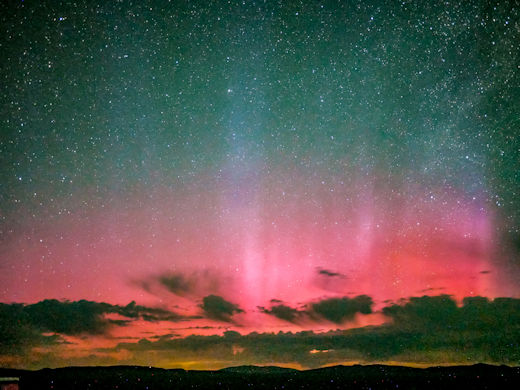
"I rolled the dice on the early arrival of the CME, and caught this at 01:36 MDT," says Shaffer.
Other notable low-latitude sightings include California, Colorado, Missouri, Utah, and maybe Louisiana. There's no guarantee of a repeat display tonight. However, sky watchers everywhere should remain alert for auroras as the solar wind in the wake of the CME is blowing faster than 900 km/s.
Realtime Aurora Photo Gallery
Free: Spaceweather.com Newsletter
THIS IS *REAL* MONEY FROM SPACE: The US Mint has just released a new $1 coin to honor NASA's longest-serving spacecraft: The Space Shuttle. On May 25, 2025, the students of Earth to Sky Calculus launched the coins to the stratosphere onboard a cosmic ray research balloon:
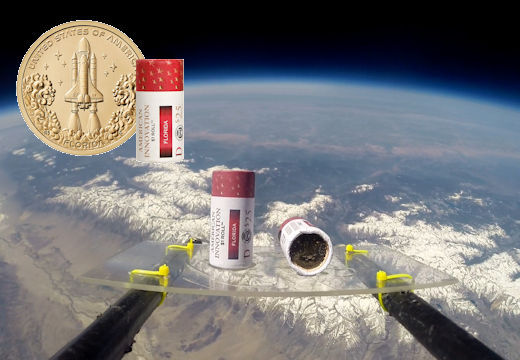
You can have a single coin for $49.95 or an entire unbroken roll for $299.95. No longer available from the US Mint, these rare coins flew 119,343 feet above the Sierra Nevada on July 16, 2024. One side shows the space shuttle lifting off from Launch Complex 39 at Florida’s Kennedy Space Center; the other side features the Statue of Liberty in profile.
For collectors: The P mint version of these coins is also available: Get the single coin ($49.95) or an entire unbroken roll ($299.95).
The students are selling space coins to support to support their cosmic ray research program. (Helium is expensive!) Each order comes with a greeting card showing the coins in flight and telling the story of their journey to the stratosphere and back again.
Far Out Gifts: Earth to Sky Store
All sales support hands-on STEM education
Realtime Space Weather Photo Gallery
Free: Spaceweather.com Newsletter
Realtime Comet Photo Gallery
Free: Spaceweather.com Newsletter
Every night, a network
of NASA
all-sky cameras scans the skies above the United
States for meteoritic fireballs. Automated software
maintained by NASA's Meteoroid Environment Office
calculates their orbits, velocity, penetration depth
in Earth's atmosphere and many other characteristics.
Daily results are presented here on Spaceweather.com.
On Jun 01, 2025, the network reported 2 fireballs.
(2 sporadics)
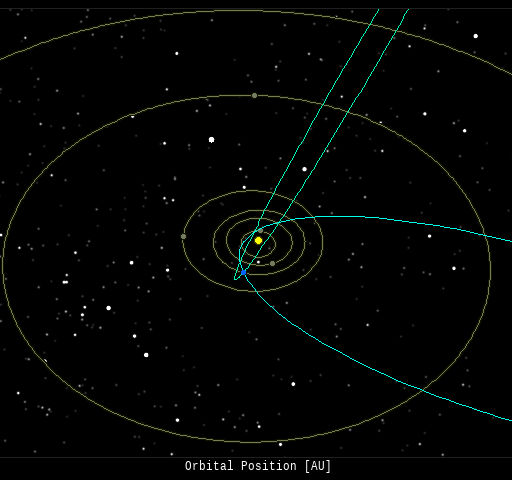
In this diagram of the inner solar system, all of the fireball orbits intersect at a single point--Earth. The orbits are color-coded by velocity, from slow (red) to fast (blue).
[Larger image] [movies]
Potentially Hazardous Asteroids ( PHAs)
are space rocks larger than approximately 100m that
can come closer to Earth than 0.05 AU. None of the
known PHAs is on a collision course with our planet,
although astronomers are finding new
ones all the time.
On June 1, 2025 there were 2349 potentially hazardous asteroids.
 |
Recent
& Upcoming Earth-asteroid encounters:
| Asteroid |
Date(UT) |
Miss Distance |
Velocity (km/s) |
Diameter (m) |
| 2025 JP |
2025-May-27 |
13.4 LD |
7 |
27 |
| 2025 KW |
2025-May-28 |
12.9 LD |
13.5 |
29 |
| 2025 JR |
2025-May-28 |
12.1 LD |
11.3 |
80 |
| 2025 KU1 |
2025-May-28 |
19.3 LD |
3.4 |
20 |
| 2025 KW8 |
2025-May-28 |
3.4 LD |
13.7 |
14 |
| 2025 KX3 |
2025-May-28 |
0.9 LD |
7.9 |
10 |
| 2025 FU5 |
2025-May-28 |
13.4 LD |
7.3 |
92 |
| 2025 KA3 |
2025-May-28 |
5 LD |
19.5 |
27 |
| 2025 KR |
2025-May-29 |
12.9 LD |
13.8 |
43 |
| 2025 KD3 |
2025-May-29 |
19.7 LD |
12.1 |
85 |
| 2025 KK |
2025-May-30 |
1.9 LD |
4.5 |
11 |
| 2025 KH2 |
2025-May-30 |
14.6 LD |
12.4 |
33 |
| 2025 KR1 |
2025-May-30 |
15 LD |
17.6 |
41 |
| 2022 KP3 |
2025-May-30 |
10.2 LD |
7.7 |
7 |
| 2025 KP |
2025-May-31 |
3.2 LD |
11.3 |
30 |
| 2025 KC1 |
2025-May-31 |
5.3 LD |
8.8 |
23 |
| 2025 KB4 |
2025-May-31 |
19.8 LD |
13.4 |
35 |
| 2025 KL2 |
2025-May-31 |
15.2 LD |
18.9 |
32 |
| 2025 KZ3 |
2025-May-31 |
1.8 LD |
2.6 |
8 |
| 2025 KE4 |
2025-May-31 |
2.7 LD |
3.6 |
5 |
| 2025 KS8 |
2025-Jun-01 |
6.4 LD |
10.3 |
20 |
| 2025 KC4 |
2025-Jun-02 |
10.7 LD |
6.7 |
23 |
| 2025 KV8 |
2025-Jun-04 |
4.7 LD |
9.3 |
25 |
| 2025 KX8 |
2025-Jun-04 |
8.4 LD |
8.3 |
38 |
| 2025 KG |
2025-Jun-04 |
15.3 LD |
3.4 |
18 |
| 2025 KY4 |
2025-Jun-05 |
7.2 LD |
3.8 |
14 |
| 424482 |
2025-Jun-05 |
9.1 LD |
6.2 |
421 |
| 2020 LQ |
2025-Jun-06 |
17.3 LD |
11.8 |
34 |
| 2018 LE4 |
2025-Jun-07 |
12.2 LD |
13.3 |
62 |
| 2014 LL26 |
2025-Jun-08 |
8 LD |
5.2 |
31 |
| 2025 KP8 |
2025-Jun-08 |
13.6 LD |
13.7 |
54 |
| 2015 XR1 |
2025-Jun-12 |
18.1 LD |
12.6 |
81 |
| 2022 KQ5 |
2025-Jun-12 |
13.6 LD |
5.1 |
5 |
| 2025 KV4 |
2025-Jun-12 |
4.1 LD |
8 |
27 |
| 2025 KF1 |
2025-Jun-12 |
8.1 LD |
9.7 |
41 |
| 2023 XO15 |
2025-Jun-15 |
17.8 LD |
3.4 |
24 |
| 2025 HN6 |
2025-Jun-16 |
6.4 LD |
2.3 |
23 |
| 2000 LF3 |
2025-Jun-17 |
18.9 LD |
14.5 |
169 |
| 2023 XU2 |
2025-Jun-18 |
11.1 LD |
15.6 |
32 |
| 2025 KT6 |
2025-Jun-19 |
7 LD |
9.1 |
76 |
| 2003 AY2 |
2025-Jun-22 |
14.2 LD |
15.9 |
386 |
| 2014 DH |
2025-Jun-28 |
17.1 LD |
12.1 |
17 |
| 2019 JM |
2025-Jul-09 |
16.6 LD |
6.9 |
14 |
| 2019 NW5 |
2025-Jul-09 |
15.2 LD |
16.5 |
65 |
| 2005 VO5 |
2025-Jul-11 |
15.9 LD |
14.4 |
382 |
| 2022 YS5 |
2025-Jul-17 |
17.4 LD |
6.1 |
38 |
| 2018 BY6 |
2025-Jul-19 |
13.7 LD |
7.4 |
69 |
Notes: LD means
"Lunar Distance." 1 LD = 384,401 km, the distance
between Earth and the Moon. 1 LD also equals 0.00256
AU.
| |
Cosmic Rays in the Atmosphere |
SPACE WEATHER BALLOON DATA: Almost once a week, Spaceweather.com and the students of Earth to Sky Calculus fly space weather balloons to the stratosphere over California. These balloons are equipped with sensors that detect secondary cosmic rays, a form of radiation from space that can penetrate all the way down to Earth's surface. Our monitoring program has been underway without interruption for 10 years, resulting in a unique dataset of in situ atmospheric measurements.
Latest results (Nov. 2024): Atmospheric radiation is sharply decreasing in 2024. Our latest measurements in November registered a 10-year low:
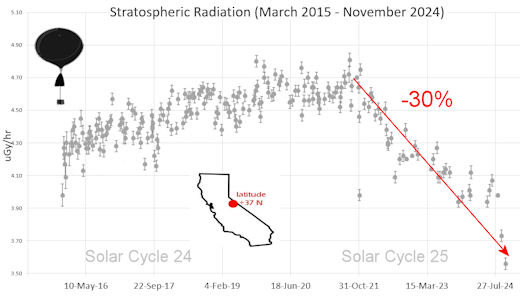
What's going on? Ironically, the radiation drop is caused by increasing solar activity. Solar Cycle 25 has roared to life faster than forecasters expected. The sun's strengthening and increasingly tangled magnetic field repels cosmic rays from deep space. In addition, solar coronal mass ejections (CMEs) sweep aside cosmic rays, causing sharp reductions called "Forbush Decreases." The two effects blend together to bring daily radiation levels down.
.Who cares? Cosmic rays are a surprisingly "down to Earth" form of space weather. They can alter the chemistry of the atmosphere, trigger lightning, and penetrate commercial airplanes. According to a study from the Harvard T.H. Chan school of public health, crews of aircraft have higher rates of cancer than the general population. The researchers listed cosmic rays, irregular sleep habits, and chemical contaminants as leading risk factors. A number of controversial studies (#1, #2, #3, #4) go even further, linking cosmic rays with cardiac arrhythmias and sudden cardiac death.
Technical notes: The radiation sensors onboard our helium balloons detect X-rays and gamma-rays in the energy range 10 keV to 20 MeV. These energies span the range of medical X-ray machines and airport security scanners.
Data points in the graph labeled "Stratospheric Radiation" correspond to the peak of the Regener-Pfotzer maximum, which lies about 67,000 feet above central California. When cosmic rays crash into Earth's atmosphere, they produce a spray of secondary particles that is most intense at the entrance to the stratosphere. Physicists Eric Regener and Georg Pfotzer discovered the maximum using balloons in the 1930s and it is what we are measuring today.
| |
The
official U.S. government space weather bureau |
| |
The
first place to look for information about sundogs,
pillars, rainbows and related phenomena. |
| |
Researchers
call it a "Hubble for the sun." SDO
is the most advanced solar observatory ever. |
| |
3D
views of the sun from NASA's Solar and Terrestrial
Relations Observatory |
| |
Realtime
and archival images of the Sun from SOHO. |
| |
information about sunspots based on the latest NOAA/USAF Active Region Summary |
| |
current counts of failed and deployed Starlink satellites from Jonathan's Space Page. See also, all satellite statistics. |
| |
Authoritative predictions of space junk and satellite re-entries |
| |
from
the NOAA Space Environment Center |
| |
fun to read, but should be taken with a grain of salt! Forecasts looking ahead more than a few days are often wrong. |
| |
from the NOAA Space Environment Center |
| |
the
underlying science of space weather |
 |
Got a chipped or cracked windshield that prevents you from seeing space weather events while driving? Get windshield replacement from SR Windows & Glass with free mobile auto glass service anywhere in the Phoenix area. |
 |
BestCSGOGambling is the best site for everything related to CSGO gambling on the web |
| |
These links help Spaceweather.com stay online. Thank you to our supporters! |
|
|
| |
|
|
|
|
 |
|
 |

 |
©2021 Spaceweather.com. All rights reserved. This site is penned daily by Dr. Tony Phillips. |
|